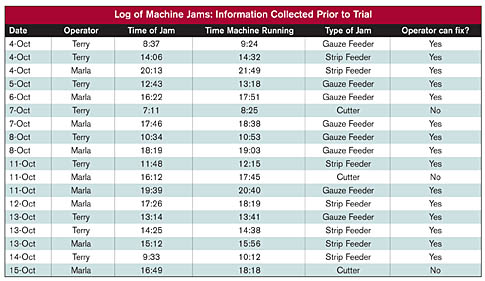Anyone who has faced a production problem with a need to solve it by using production data can relate to the notion of a brain teaser. The brain teasers presented here are based on real-world situations that are encountered by workers in manufacturing environments. The brain teasers have three parts: (1) the situation, (2) available data or other supporting information and (3) questions that various workers want answered for continual improvement. Recommended solutions follow in the next issue and on the Web at Quality Online (www.qualitymag.com).
Situation
Terry and Marla are machine operators for a company that makes a variety of sterile dressings, such as adhesive bandages and gauze pads, for the mass market. Currently, they run an adhesive bandage machine with Terry on first shift and Marla on second. Their machine is old and jams frequently. Only maintenance personnel are authorized to work on the machines. Because maintenance is often occupied with other assignments, the machine jams can lead to excessive lost time and high scrap.
At a shift meeting, Terry and Marla lobbied for permission to fix the jammed machine themselves. They agreed to keep a detailed log of jams so that their shift supervisor, Annette, could present the idea at a production meeting. This log will include the time of the jam, the time the machine began running again, the location of the jam, the type of jam and the jams Terry and Marla could fix on their own. After two weeks, Annette took the information to a production meeting. She asked for a 2-week trial with Terry and Marla fixing certain types of jams. At the end of the trial period, Annette will present the results to the production team and together they will make a decision about operators fixing some jams.

Available data
Information for the 2 weeks prior to the trial, as well as data for the 2-week trial, are given in the tables entitled, "Log of Machine Jams." Use this information to answer the questions that follow.

Questions
1. How much lost time incurred during the two weeks prior to the trial period?
2. Is the time lost for the jams during this period predictable?
3. How much lost time incurred during the two-week trial? Is this lost time predictable?
4. Is the evidence sufficient to recommend that Terry and Marla fix some types of jams rather than wait on maintenance?
